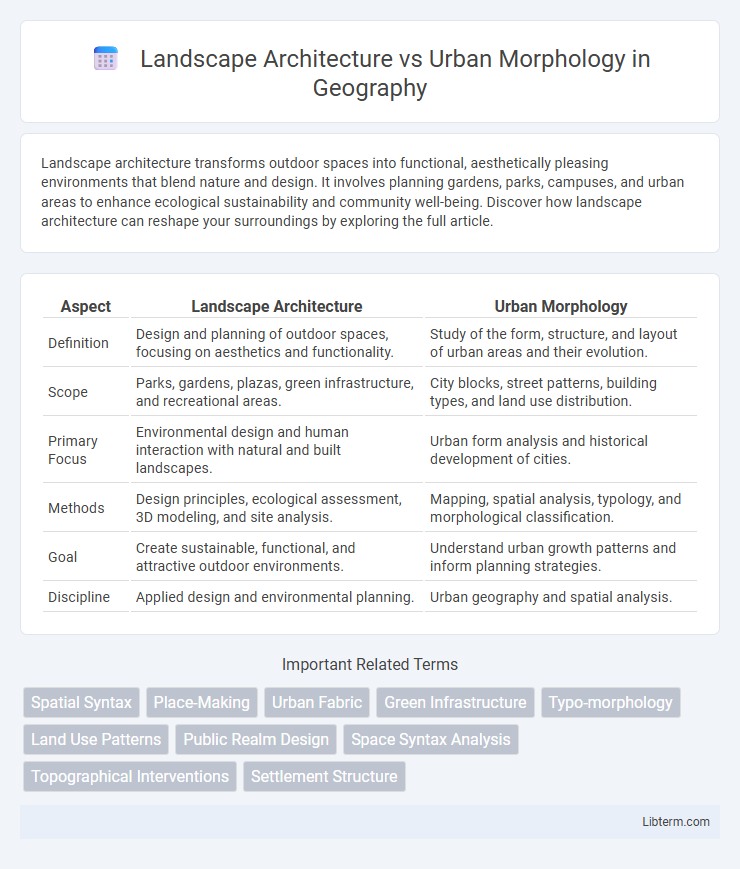Landscape architecture transforms outdoor spaces into functional, aesthetically pleasing environments that blend nature and design. It involves planning gardens, parks, campuses, and urban areas to enhance ecological sustainability and community well-being. Discover how landscape architecture can reshape your surroundings by exploring the full article.
Table of Comparison
| Aspect | Landscape Architecture | Urban Morphology |
|---|---|---|
| Definition | Design and planning of outdoor spaces, focusing on aesthetics and functionality. | Study of the form, structure, and layout of urban areas and their evolution. |
| Scope | Parks, gardens, plazas, green infrastructure, and recreational areas. | City blocks, street patterns, building types, and land use distribution. |
| Primary Focus | Environmental design and human interaction with natural and built landscapes. | Urban form analysis and historical development of cities. |
| Methods | Design principles, ecological assessment, 3D modeling, and site analysis. | Mapping, spatial analysis, typology, and morphological classification. |
| Goal | Create sustainable, functional, and attractive outdoor environments. | Understand urban growth patterns and inform planning strategies. |
| Discipline | Applied design and environmental planning. | Urban geography and spatial analysis. |
Introduction to Landscape Architecture and Urban Morphology
Landscape Architecture focuses on the design and planning of outdoor spaces to create functional, sustainable, and aesthetically pleasing environments. Urban Morphology studies the form, structure, and layout of urban spaces, analyzing the patterns and processes shaping cities over time. Both disciplines intersect in understanding spatial organization but differ in scale and emphasis--Landscape Architecture prioritizes ecological integration and user experience, while Urban Morphology emphasizes historical development and spatial configuration.
Defining Landscape Architecture
Landscape architecture involves the design and planning of outdoor spaces, integrating natural and built environments to create functional, sustainable, and aesthetically pleasing landscapes. It focuses on elements like topography, vegetation, water management, and spatial organization to enhance ecological balance and human experience. Urban morphology, in contrast, studies the form, structure, and evolution of urban spaces, analyzing patterns of streets, buildings, and land use over time.
Understanding Urban Morphology
Urban Morphology examines the form, structure, and layout of cities to understand historical development patterns and spatial organization. It analyzes elements like street networks, plot divisions, and building types to reveal how urban environments evolve over time. This study supports informed planning by linking physical form with social, economic, and cultural processes shaping urban growth.
Historical Evolution of Both Disciplines
Landscape architecture emerged during the Renaissance as a response to the need for aesthetically pleasing, functional outdoor spaces, evolving through significant movements like the English Landscape Garden and modernist design principles. Urban morphology, developing primarily in the 20th century, focuses on the study of the form and structure of urban spaces, tracing the historical patterns of city growth and spatial organization from ancient civilizations to contemporary urban development. Both disciplines share roots in understanding human-environment interactions but differ as landscape architecture emphasizes design and aesthetics, while urban morphology centers on analytical frameworks of urban form evolution.
Core Differences Between Landscape Architecture and Urban Morphology
Landscape architecture emphasizes designing outdoor spaces to enhance environmental quality, aesthetics, and human interaction with nature, focusing on elements like vegetation, landforms, and water features. Urban morphology studies the form, structure, and layout of urban spaces, analyzing patterns of streets, plots, and buildings to understand city evolution and spatial organization. The core difference lies in landscape architecture's practice-oriented approach to shaping natural and built environments versus urban morphology's analytical perspective on city form and development processes.
Overlapping Principles and Shared Goals
Landscape Architecture and Urban Morphology both emphasize the integration of natural and built environments to create sustainable, functional spaces. They share principles such as spatial organization, human-centered design, and ecological sensitivity to enhance livability and resilience in urban settings. Collaborative approaches between these fields optimize land use, connectivity, and environmental quality to foster vibrant, adaptable communities.
Methodologies: Analytical vs. Design Approaches
Landscape architecture employs design-centered methodologies that emphasize aesthetic, functional, and ecological integration in outdoor spaces, often utilizing site analysis, spatial composition, and environmental context to guide creative interventions. Urban morphology relies on analytical approaches to study the form, structure, and evolution of urban patterns by examining street networks, plot configurations, and building typologies to understand historical development and spatial dynamics. These contrasting methodologies highlight landscape architecture's focus on innovative design solutions versus urban morphology's systematic examination of urban form and growth processes.
Impacts on Urban Planning and Development
Landscape architecture shapes urban planning by integrating ecological sustainability, green infrastructure, and public spaces, enhancing environmental quality and community well-being. Urban morphology analyzes spatial patterns, street networks, and building forms, guiding the organization and evolution of urban areas to optimize functionality and connectivity. The combined insights from both disciplines influence urban development strategies by balancing natural elements with built environments to create resilient, livable cities.
Future Trends in Landscape Architecture and Urban Morphology
Future trends in landscape architecture emphasize sustainable design, integrating green infrastructure such as urban forests and permeable surfaces to enhance ecological resilience and climate adaptation. Urban morphology is evolving through the analysis of spatial patterns using AI and GIS technologies to optimize land use, improve walkability, and support smart city development. Both fields converge on promoting livable, adaptive urban environments that balance human needs with environmental stewardship.
Conclusion: Bridging Design and Urban Form
Landscape architecture and urban morphology together shape sustainable, functional urban environments by integrating natural systems with built form. Emphasizing ecological processes and human experiences, these disciplines collaborate to create adaptive, resilient spaces that respond to social, environmental, and spatial dynamics. Bridging design with urban form enhances connectivity, fosters biodiversity, and supports vibrant, livable cities.
Landscape Architecture Infographic

 libterm.com
libterm.com